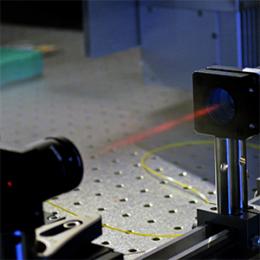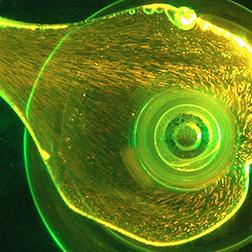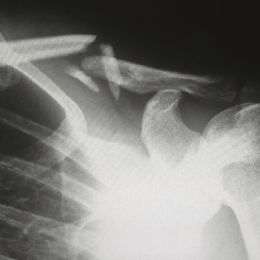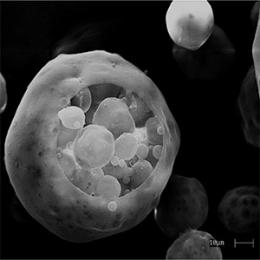
Research Groups

Adie Lab
The Adie Lab research focuses on the development and application of novel optical imaging methods for basic science investigations and clinical applications. The Lab's main imaging modality is optical coherence tomography (OCT), which can provide 3D label-free imaging of tissue structure and function in vivo. OCT can be thought of as the optical analogue of ultrasound, but with the advantage that ‘optical echo’ measurements support much higher resolution.

Antaki Lab
The Antaki Lab focuses on the development of blood-wetted medical devices. Equally important as the devices themselves, the lab’s research focuses on the methodology by which they are designed, and used clinically. The Lab's current research emphasis involves five application areas: circulatory support systems for children, decision-support tools for severe heart failure, diagnostic technology for the home and point-of-care to improve patient engagement, multi-scale modeling of thrombosis in artificial circulation, and development of medical devices for global health. A nascent, overarching project aims to accelerate medical innovation by professional networking between physicians, medical product designers, and patients. Although these interests are diverse, they share a common theme of improving healthcare though biomedical engineering.

Bonassar Lab
The Bonassar Lab focuses on the regeneration and analysis of musculoskeletal tissues, including bone and cartilage. The approach involves a multidisciplinary strategy using techniques in biomechanics, biomaterials, cell biology, and biochemistry.

Brito Lab
The Brito Lab is pioneering new technologies that allow us to peer into the gut microbiomes of humans, animals and even environmental microbiomes to understand gene flow in these natural microbial communities. The Lab uses experimental and computational approaches in the hope that their work will enhance our understanding of microbial ecology and inform current efforts to combat antibiotic resistance.

Butcher Lab
The Butcher Lab cardiovascular developmental bioengineering laboratory identifies the principals regulating embryonic valvular development and uses the findings to motivate regenerative engineering strategies for heart and valve disease.

Cira Lab
The Cira Lab engages in a diverse set of efforts in quantitative biology, fluid physics, and microfluidic devices.

Cosgrove Lab
The Cosgrove Lab develops and utilizes systems bioengineering approaches to study the signaling network alterations underlying the decline of stem cell function and tissue regeneration in aging and disease.

De Vlaminck Lab
The De Vlaminck Lab is a biomedical and single-cell genomics lab with a mission to develop novel measurement principles in molecular diagnostics and single-cell biology. This research brings approaches from biophysics and genomics to biomedicine. Most of the lab's work exploits next-generation DNA sequencing.

Doerschuk Lab
The Doerschuk Research Group develops, validates, and uses mathematical models of primarily biological and medical systems, mostly with the goal of understanding experimental data. The range of problems has been broad, e.g., ethanol pharmacokinetics in human subjects based on breath-analyzer data to the 4-D spatial-temporal dynamics of virus particles based on single-particle cryo electron microscopy images. Most of the work is in collaboration with a domain expert whose research group performs the experiments. Most of the work is of a statistical character. The most successful work often involves systems where something is understood about the physical – chemical basis of the system and/or the measurement process. Some of the problems are “big data” problems, e.g., 100,000 images in single-particle cryo electron microscopy. The group’s two goals are to develop new interesting ideas in modeling and inference and to solve our collaborators’ problems!

Fischbach Lab
The Fischbach Lab applies multidisciplinary strategies to gain a better qualitative and quantitative understanding of the microenvironmental conditions fundamental to the pathogenesis and therapy of cancer. The Lab's research areas include: Tumor-stroma interactions in cancer pathogenesis, Tumor metastasis in engineered bone microenvironments, 3-D in vitro models of vascularized tumors and tumor angiogenesis, and Engineered Microenvironments to Study Brain Cancer Tumorigenesis.

Jiang Lab
The Jiang lab focuses on the understanding and development of next-generation biomaterials, particularly zwitterionic functional materials, for biomedical and engineering applications, including viral and non-virial protein and gene delivery carriers, implantable materials, stem cell cultures, blood-contact devices, biosensors and marine coatings. His research interests include immune-modulating materials, cancer immunotherapy, vaccine and immunosuppression.

Kwan Lab
The Kwan Lab applies systems neuroscience and neural engineering approaches to the study of mental health. Our recent work focuses on determining the action of psychiatric drugs in the brain, using molecular, optical imaging, electrophysiological, and behavioral methods.

Lammerding Lab
The Lammerding Lab investigates the intricate interplay between cellular structure, mechanics and function through an interdisciplinary research approach that combines engineering principles, microfabrication, and cell and molecular biology techniques, as well as the development and application of novel experimental assays. The team is composed of students and postdoctoral researchers with a broad range of backgrounds, including (biomedical) engineering, biology, chemistry and other life sciences, who explore creative solutions to relevant biological and clinical problems. Research is focused on the nuclear envelope and its interface with the surrounding cytoskeleton, as mutations in nuclear envelope proteins are responsible for more than 10 human diseases, such as muscular dystrophy, dilated cardiomyopathy, premature aging (Hutchison-Gilford progeria syndrome), and numerous cancers.

Lee Lab
The Lee laboratory focuses on the morphogenesis, homeostasis and disease pathogenesis of lymphatic vessels and blood vessels and their microenvironments to provide new strategies for regenerative medicine and treatment of cancer, immune diseases, and edema. To this end, the laboratory is working to develop novel three-dimensional (3D) organ-on-chip systems, cellular and molecular tools, and in vivo models to better understand the mechanisms by which cells regulate and respond to biological and mechanical cues.

Lewis Lab
The Lewis lab focuses on understanding the interplay of mechanical cues and biological changes in musculoskeletal tissues. Specifically, the interrogate how the acute sensing mechanisms in musculoskeletal cells relate to tissue level changes in healthy and disease states. Investigations in bone are focused on understanding how bone cells interpret mechanical loading in real time using intravital imaging techniques. The lab is also interested in understanding how bone interacts with other neighboring tissues in the onset and progression of diseases like osteoarthritis and osteoporosis.

Putnam Lab
The Putnam Lab's research focuses on development of vaccines, systems for controlled drug delivery, and biomimetic polymers.

Schaffer-Nishimura Lab
The Schaffer-Nishimura Lab focuses on the use of nonlinear optical interactions between femtosecond-duration laser pulses and biological material as a tool for precise ablation of structures and quantitative observation of dynamical processes in live biological samples.

van der Meulen Lab
The van der Meulen Lab focuses on understanding musculoskeletal adaptation in vivo. Historically the Lab's interest has primarily been bone, but has expanded to consider more of the musculoskeletal system with recent studies examining cartilage and joint adaptation. In the bone biomechanics area the Lab is interested in the determinants of bone strength and the relationship of whole bone strength to nano- and microscale tissue properties.

Van Vliet Lab
The Van Vliet Lab specializes in material chemomechanics – the coupling between chemistry and mechanics at material interfaces. Applications include optimizing materials for renewable energy and developing new materials and methods for cell therapies and drug screening.

Yadong Wang Lab
Under the direction of McAdam Family Foundation Professor of Heart Assist Technology Yadong Wang, the Wang Lab's focus is on biomaterial design, processing, and application. The Lab creates biomaterials that present controlled chemical, physical, and mechanical signals to cells, tissues and organs. The ultimate goal is to control how the human body interacts with these materials. The lab is especially interested in applications of biomaterials in the cardiovascular, nervous and musculoskeletal systems. The team enjoys collaborating with other scientists and clinicians who share the same passion in translational research. Current projects include vascular grafts, controlled release of proteins and microfabrication of biomaterials.

Yi Wang Lab
The Cornell MRI Research lab is dedicated to research and education in magnetic resonance imaging. The group includes scientists from Computer Science, Engineering, Physics, and clinical investigators from Cardiology, Neurology, Radiology, and Surgery, as well as students from graduate programs form Cornell's Ithaca and Weill campuses. Research activities are interdisciplinary and interactive between science and medicine. Ph.D. thesis projects typically focus on technical developments for clinical and pre-clinical applications in cardiovascular, cancer & neurological diseases.

Zipfel Lab
The Zipfel Lab develops optical imaging, spectroscopy and bioanalytical instrumentation, along with related methodologies designed to enhance biophysical, biological and biomedical research. The Lab applies these technologies in collaboration with other laboratories in areas such as cancer biology, studies of nuclear structure and chromatin conformation, enhancer-promotor interactions, and protein complex stoichiometry/function determinations. The lab also develops optical instrumentation for applications in disease detection and monitoring.
The techniques and skill sets used in the lab range from biochemistry, molecular biology and photophysical analysis methods to optical and electronic design, as well as software development in C/C++ for tasks related to data analysis, instrument control and image processing.
Decoding Brain Activity
Spotlight on Schaffer-Nishimura Lab Postdoc and L’Oréal USA For Women in Science fellow, Laurie Bizimia.

